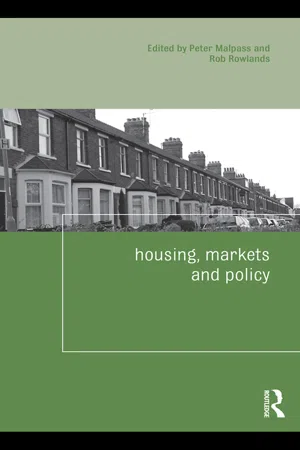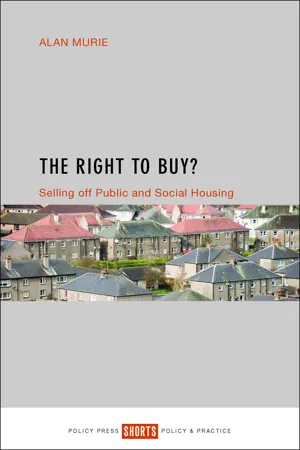History
Housing Act 1980
The Housing Act 1980 was a significant piece of legislation in the United Kingdom that aimed to increase homeownership by allowing council tenants to purchase their homes at a discounted price. This policy, known as the Right to Buy scheme, had a profound impact on the housing market and social structure, leading to a significant increase in owner-occupied housing.
Written by Perlego with AI-assistance
Related key terms
4 Key excerpts on "Housing Act 1980"
- eBook - ePub
Decent Homes for All
Planning's Evolving Role in Housing Provision
- Nick Gallent, Mark Tewdwr-Jones(Authors)
- 2006(Publication Date)
- Routledge(Publisher)
Table 3.1 . Despite the gradual increase in sales throughout the 1960s and 1970s, the obligatory demunicipalisation introduced by the Housing Act 1980 – in the form of an individual Right to Buy – was to produce an unprecedented decline in public sector housing provision (Malpass and Murie, 1987: 98; see also Jones and Murie, 2006). In the immediate aftermath of the Conservative election victory of 1979, the introduction of an obligatory sales policy was seen as the ‘most effective way of expanding homeownership’ (Malpass and Murie, 1987: 99). It also shifted the the emphasis of housing policy onto private rather than public sector solutions.Condemnation of the 1980 legislation on the part of the Government's political opponents was swift; the housing organisation Shelter, claimed that 60 per cent of all local authorities in England and Wales were opposed to the obligatory sale of public housing (including 30 per cent of Conservative-controlled councils). Similarly, ‘the Labour Party Conference of 1979 endorsed the National Executive Committee's statement condemning the Conservative policy of selling council houses, and carried a motion that the next Labour Government would repeal the 1980 Act’ (Balchin, 1981: 137). But despite considerable opposition to the legislation, the new Housing Act was passed through Parliament on 8 August 1980. Eight weeks later, on 3 October, Chapter I of Part I of the Act relating to secure tenants’ RTB came into force (Aldridge, 1980: 4). Our intention now is to consider the background to the 1980 Housing Act and those developments in housing policy that made it possible for the state to essentially drop the well-established idea of public provision of affordable housing. Investment in housing associations created a context in which housing policy was able to move in a different direction (away from public sector intervention), but this does not explain the apparently seismic ideological shift that appeared to occur in 1980. But the Housing Act of that year was not a departure from past thinking (on the part of the Conservatives) but simply the fulfilment of an ideological vision that had been present for a hundred years. Successive Conservative governments had sought to rein-back support for public housing but none had had a mandate for a full withdrawal (or the right plan for such a withdrawal) until 1979. The arrival of the first Thatcher government began a chain of events – a golden age for housing associations followed by their decline and a new reliance on private provision – that set the stage for the current policy context: where public provision is minimum, housing associations (now RSLs) struggle to make any impact in the housing market, and the private sector is called upon to ‘trailblaze’, embracing all manner of new initiatives – sustainable communities, planning gain, planning tariffs, £60,000 homes, affordability targets – aimed at recreating the pool of affordable homes that the country appears to so desperately need, but which has been depleted over the last quarter of a century. - eBook - ePub
- Peter Malpass, Rob Rowlands(Authors)
- 2009(Publication Date)
- Routledge(Publisher)
Finally, the continuing decline of the private rented sector came to be seen as inevitable, after the failure of the 1957 Rent Act to revive it, the scandal of Rachmanism, and the work of the Milner Holland Committee (Great Britain, 1965) on the private rented sector in London. The combined effects of lack of investment, slum clearance, sales into owner-occupation—either to sitting tenants or with vacant possession—and, in some cases, municipal or housing association acquisitions seemed to be sounding a death knell for a form of tenure that was considered outdated and inappropriate in a modern world. This was fertile ground for the supporters of housing associations, the ‘voluntary’ housing sector, to expand their role in the acquisition and improvement of older private rented housing and in new building as a source of good-quality rented housing for people in need. The Housing Act, 1974, in effect planned by the Conservative government and enacted by the Labour government elected in 1974, created very favourable conditions for the future growth of a generously subsidised, and what would now be termed a ‘reformed’ and ‘modernised’, voluntary housing movement.Tenure was important as a framework for housing policy and, despite the official encouragement of local authorities to take a comprehensive approach to the formulation and implementation of housing policies at local level, this advice, though emanating from central government, was generally not followed at national level. Different legal and financial regimes applied to each of the three main tenures; standards for both existing and new housing differed between tenures; levels of council-house building were often determined as a residual of what was being built for owner-occupation; and notwithstanding the adoption of ‘fair rents’ as a principle to be applied to the council sector from 1972 (a system introduced by Labour in 1965 for the independent determination of rents in the private rented sector), the suggestion that this would provide ‘a fairer choice between owning a home and renting one’ or ‘fairness between one citizen and another in giving and receiving help towards housing costs’ (Great Britain, 1971: 1) was plainly wrong. For example, the more tenants earned, the less they received in rent rebate; while the more owner-occupiers earned, the more they received in mortgage interest tax relief (Murie et al - eBook - ePub
- (Author)
- 2015(Publication Date)
- Straightforward Publishing Digital(Publisher)
6
Public Sector-Secure Tenancies
The 1980 Housing Act introduced the right to buy for public sector tenancies and also introduced a measure of protection hitherto absent. The 1985 Housing Act consolidated the 1980 Housing Act. Over the years since its inception, the 1985 Housing Act has been subject to a number of amendments, notably the 1988 Housing Act, which will be discussed later, and which shifted Housing Associations from the public sector to the private sector, but not local authorities. All tenancies granted by local authorities and housing associations before January 15th 1989 are secure tenancies, with the exception of certain tenancies listed below. One specific exception is if a tenancy has been demoted due to anti-social behaviour. Security is lost this way.Secure tenancies
The Housing Act 1985 s 79 (1) defines a secure tenancy as:1) A tenancy under which a dwelling house is let as a separate dwelling is a secure tenancy at any time when the condition described in s 80 and 81 as the landlord condition and the tenant condition is satisfied.There must be a tenancy of a dwelling house which is let as a separate dwelling. Unlike private sector legislation, the 1985 Housing Act does not exclude licences from statutory protection.As far as security is concerned, a secure tenancy, as defined by the 1985 Act, will lose security if one of the conditions creating a secure tenancy is not present. We will be considering the conditions below. One of the main conditions, as we shall see, is that of maintaining the home as an only or principle home. Failure to do this, i.e. by residing elsewhere will render the tenancy non-secure. However, if at a later date, the condition becomes satisfied, i.e. the tenant moves back in then security is retained (Hussey v Camden Council 1995 27 HLR.5 CA). Where possession proceedings are brought, in deciding whether security of tenure has been lost the courts will look at the situation that existed at the expiry of the notice to quit. - eBook - ePub
The Right to Buy?
Selling off public and social housing
- Murie, Alan(Authors)
- 2016(Publication Date)
- Policy Press(Publisher)
Before 1979 the demand for discretionary house sales policies was less evident in Scotland than England. In the postwar period, housing in Scotland was the responsibility of the Scottish Office, and its approaches did not mirror those in England. Until 1979, a general consent for council house sales had only operated in Scotland between 1972 and 1974 (Scottish Development Department, 1972, 1974). This does not mean that the Scottish Office did not approve individual cases, and its capacity to assess these was arguably greater than in England. Between 1970 and 1973, 62 Scottish councils sold a total of 892 council dwellings; only 19 councils had sold 10 or more dwellings, and 31% of all sales had been in Edinburgh. The general consent generated 6,972 sales between 1973 and 1979.The Housing Tenants’ Rights Etc Act (Scotland) 1980 enacted the same Right to Buy proposals as England and Wales, but following devolution, in 1998 the Scottish Parliament and government made changes because of the pressures that the Right to Buy was placing on the social housing sector (Jones and Murie, 2006, pp 42-46). The Housing (Scotland) Act 2001 did not alter arrangements for existing tenants who retained a Preserved Right to Buy with a qualifying period of two years and discounts of 60% for houses and 70% for flats. For new or transferring tenants (taking up a tenancy after 30 September 2002) introduced a ‘Modernised’ Right to Buy with less generous discounts (starting at 20% after 5 years and rising by 1% for every additional year of tenancy to a maximum of 35% after 20 years and with a cash maximum of £15,000). The Modernised Right to Buy would also apply to most housing association tenants after 10 years, although housing associations could apply to the Scottish government to extend this period.The ‘Modernised’ Right to Buy introduced a common set of rights, within a single standard secure tenancy for all social sector tenants, introduced at the same time. Tenants who already had the Right to Buy had their existing rights ring-fenced, and the longer qualifying period and lower discounts (with the same rates for flats and houses) only applied to new tenants. The Housing (Scotland) Act 2001 also introduced a procedure for the identification and designation of pressured areas where the Right to Buy would be suspended, to safeguard the continued availability of social rented housing. The thinking behind these changes was that the Right to Buy had been operating in isolation or possibly at variance with other policies. Compared with other policies (including cash incentives for tenants to move elsewhere to buy), the Right to Buy was expensive and it could cause problems in some areas. The conclusion was that it should be ‘rebalanced rather than removed’, to meet the aspirations of low-income households and the objectives of communities (Jones and Murie, 2006).
Learn about this page
Index pages curate the most relevant extracts from our library of academic textbooks. They’ve been created using an in-house natural language model (NLM), each adding context and meaning to key research topics.



